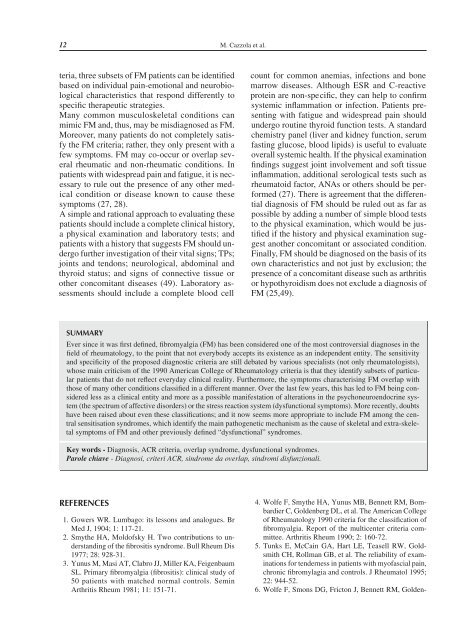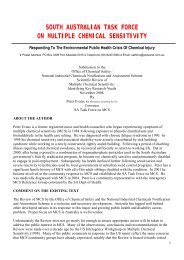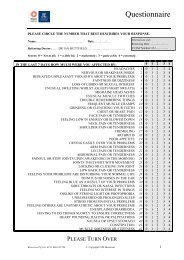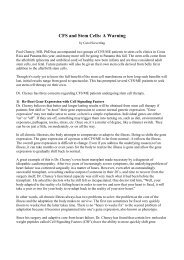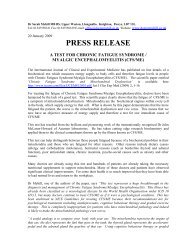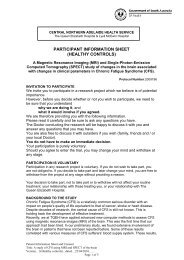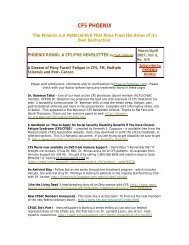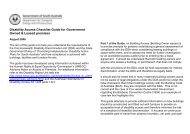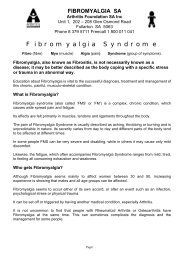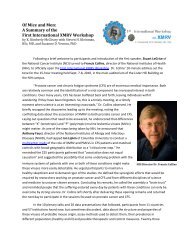12 M. Cazzola et al.teria, three subsets of FM patients can be identifiedbased on individual pain-emotional and neurobiologicalcharacteristics that respond differently tospecific therapeutic strategies.Many common musculoskeletal conditions canmimic FM and, thus, may be misdiagnosed as FM.Moreover, many patients do not completely satisfythe FM criteria; rather, they only present with afew symptoms. FM may co-occur or overlap severalrheumatic and non-rheumatic conditions. Inpatients with widespread pain and fatigue, it is necessaryto rule out the presence of any other medicalcondition or disease known to cause thesesymptoms (27, 28).A simple and rational approach to evaluating thesepatients should include a complete clinical history,a physical examination and laboratory tests; andpatients with a history that suggests FM should undergofurther investigation of their vital signs; TPs;joints and tendons; neurological, abdominal andthyroid status; and signs of connective tissue orother concomitant diseases (49). Laboratory assessmentsshould include a complete blood cellcount for common anemias, infections and bonemarrow diseases. Although ESR and C-reactiveprotein are non-specific, they can help to confirmsystemic inflammation or infection. Patients presentingwith fatigue and widespread pain shouldundergo routine thyroid function tests. A standardchemistry panel (liver and kidney function, serumfasting glucose, blood lipids) is useful to evaluateoverall systemic health. If the physical examinationfindings suggest joint involvement and soft tissueinflammation, additional serological tests such asrheumatoid factor, ANAs or others should be performed(27). There is agreement that the differentialdiagnosis of FM should be ruled out as far aspossible by adding a number of simple blood teststo the physical examination, which would be justifiedif the history and physical examination suggestanother concomitant or associated condition.Finally, FM should be diagnosed on the basis of itsown characteristics and not just by exclusion; thepresence of a concomitant disease such as arthritisor hypothyroidism does not exclude a diagnosis ofFM (25,49).SUMMARYEver since it was first defined, fibromyalgia (FM) has been considered one of the most controversial diagnoses in thefield of rheumatology, to the point that not everybody accepts its existence as an independent entity. The sensitivityand specificity of the proposed diagnostic criteria are still debated by various specialists (not only rheumatologists),whose main criticism of the 1990 American College of Rheumatology criteria is that they identify subsets of particularpatients that do not reflect everyday clinical reality. Furthermore, the symptoms characterising FM overlap withthose of many other conditions classified in a different manner. Over the last few years, this has led to FM being consideredless as a clinical entity and more as a possible manifestation of alterations in the psychoneuroendocrine system(the spectrum of affective disorders) or the stress reaction system (dysfunctional symptoms). More recently, doubtshave been raised about even these classifications; and it now seems more appropriate to include FM among the centralsensitisation syndromes, which identify the main pathogenetic mechanism as the cause of skeletal and extra-skeletalsymptoms of FM and other previously defined “dysfunctional” syndromes.Key words - Diagnosis, ACR criteria, overlap syndrome, dysfunctional syndromes.Parole chiave - Diagnosi, criteri ACR, sindrome da overlap, sindromi disfunzionali.REFERENCES1. Gowers WR. Lumbago: its lessons and analogues. BrMed J, 1904; 1: 117-21.2. Smythe HA, Moldofsky H. Two contributions to understandingof the fibrositis syndrome. Bull Rheum Dis1977; 28: 928-31.3. Yunus M, Masi AT, Clabro JJ, Miller KA, FeigenbaumSL. Primary fibromyalgia (fibrositis): clinical study of50 patients with matched normal controls. SeminArthritis Rheum 1981; 11: 151-71.4. Wolfe F, Smythe HA, Yunus MB, Bennett RM, BombardierC, Goldenberg DL, et al. The American Collegeof Rheumatology 1990 criteria for the classification offibromyalgia. Report of the multicenter criteria committee.Arthritis Rheum 1990; 2: 160-72.5. Tunks E, McCain GA, Hart LE, Teasell RW, GoldsmithCH, Rollman GB, et al. The reliability of examinationsfor tenderness in patients with myofascial pain,chronic fibromylagia and controls. J Rheumatol 1995;22: 944-52.6. Wolfe F, Smons DG, Fricton J, Bennett RM, Golden-
Fibromyalgia syndrome: definition and diagnostic aspects 13berg DL, Gerwin R, et al. The fibromyalgia and myofascialpain syndromes: a preliminary study of tenderpoints and trigger points in persons with fibromyalgia,myofascial pain syndromes and no disease. J Rheumatol1992; 19: 944-51.7. Croft P, Schollum J, Silman A. Population study of tenderpoints counts and pain as evidence of fibromyalgia.BMJ 1994; 309: 944-511.8. Hudson JI, Pope HG Jr. Fibromyalgia and psychopathology:is fibromyalgia a form of “affective spectrumdisorder?” J Rheumatol 1989; 19: 15-22.9. Yunus MB. Dysfunctional Spectrum Syndrome: a unifiedconcept for many common maladies. FibromyalgiaFrontiers 1996; 4: 3.10. Yunus MB. Fibromyalgia and overlapping disorders:the unifying concept of central sensitivity syndromes.Semin Arthritis Rheum 2007; 36: 339-56.11. Winfield JB. Fibromyalgia and related central sensitivitysyndromes: twenty-five years of progress. SeminArthritis Rheum 2007; 36: 335-8.12. Yunus MB. Central sensitivity syndromes: a new paradigmand group nosology for fibromyalgia and overlappingconditions, and the related issue of disease versusillness. Semin Arthritis Rheum 2008 [Epub aheadof print].13. Wolfe F. Fibromyalgia: the clinical syndrome. RheumDis Clin North Am 1989; 15: 1-18.14. Granges G, Littlejohn G. Pressure pain threshold inpain-free subjects, in patients with chronic regional painsyndromes, and in patients with fibromyalgia. ArthritisRheum 1993; 36: 642-6.15. Staud R. The abnormal central pain processing mechanismin patients with fibromyalgia. FibromyalgiaFrontiers 2002; 10: 18.16. Crofford LJ, Clauw DJ. Fibromyalgia: where are we adecade after the American College of Rheumatologyclassification criteria were developed? Editorial. ArthritisRheum 2002; 46: 1136-7.17. Wolfe F. The relation between tender points and fibromyalgiasymptom variables: evidence that fibromyalgiais not a discrete disorder in the clinic. AnnRheum Dis 1997; 56: 268-71.18. Hazemeijer I, Rasker JJ. Fibromyalgia and the therapeuticdomain. A philosophical study on the origins offibromyalgia in a specific social setting. Rheumatology2003; 42: 507-15.19. Ehrlich GE. Pain is real; fibromyalgia isn't. J Rheumatol.2003; 30: 1666-7.20. Wolfe F. The fibromyalgia problem. J Rheumatol 1997;24: 1247-9.21. Fukuda K, Nisenbaum R, Stewart G, Thompson WW,Robin L, Washko RM, et al. Chronic multisymptom illnessaffecting Air Force veterans of the Gulf War. JA-MA 1998; 280: 981-8.22. Turk DC, Okifuji A, Sinclair JD, Starz TW. Pain, disability,and physical functioning in subgroups of patientswith fibromyalgia. J Rheumatol 1996; 23: 1255-62.23. Giesecke T, Williams DA, Harris RE, Cupps TR, TianX, Tian TX, et al. Subgrouping of fibromyalgia patientson the basis of pressure-pain thresholds and psychologicalfactors. Arthritis Rheum 2003; 48: 2916-22.24. Katz RS, Wolfe F, Michaud K. Fibromyalgia diagnosis:a comparison of clinical, survey, and AmericanCollege of Rheumatology criteria. Arthritis Rheum2006; 54: 169-76.25. Bliddal H, Danneskiold-Samsøe B. Chronic widespreadpain in the spectrum of rheumatological diseases.BestPract Res Clin Rheumatol 2007; 21: 391-402.26. Fitzcharles MA, Boulos P. Inaccuracy in the diagnosisof fibromyalgia syndrome: analysis of referrals.Rheumatology 2003; 42: 263-7.27. Schneider MJ, Brady DM, Perle SM. Commentary: differentialdiagnosis of fibromyalgia syndrome: proposalof a model and algorithm for patients presenting withthe primary symptom of chronic widespread pain. JManipulative Physiol Ther 2006; 29: 493-5<strong>01</strong>.28. Martínez-Lavín M. Overlap of fibromyalgia with othermedical conditions.Curr Pain Headache Rep 20<strong>01</strong>;5: 347-50.29. Bennett R. The concurrence of lupus and fibromyalgia:implications for diagnosis and management. Lupus1997; 6: 494-9.30. Middleton GD, McFarlin JE, Lipsky PE. The prevalenceand clinical impact of fibromyalgia in systemiclupus erythematosus. Arthritis Rheum 1994; 37: 1181-8.31. Morand EF, Miller MH, Whittingham S, Littlejohn GO.Fibromyalgia syndrome and disease activity in systemiclupus erythematosus. Lupus 1994; 3: 187-91.32. Akkasilpa S, Goldman D, Magder LS, Petri M. Numberof fibromyalgia tender points is associated withhealth status in patients with systemic lupus erythematosus.J Rheumatol 2005; 32: 48-50.33. Kötter I, Neuscheler D, Günaydin I, Wernet D, KleinR. Is there a predisposition for the development of autoimmunediseases in patients with fibromyalgia? Retrospectiveanalysis with long term follow-up. RheumatolInt 2007; 27: 1031-9.34. Buskila D, Press J, Abu-Shakra M. Fibromyalgia insystemic lupus erythematosus: prevalence and clinicalimplications. Clin Rev Allergy Immunol 2003; 25:25-8.35. Bonafede RP, Downey DC, Bennett RM An associationof fibromyalgia with primary Sjogren’s syndrome: aprospective study of 72 patients. J Rheumatol 1995;22: 133-6.36. Wolfe F, Hawley DJ, Wilson K. The prevalence andmeaning of fatigue in rheumatic disease. J Rheumatol1996; 23: 1407-17.37. Hidding A, van Santen M, De Klerk E, Gielen X, BoersM, Geenen R, et al Comparison between self-reportmeasures and clinical observations of functional disabilityin ankylosing spondylitis, rheumatoid arthritisand Fibromyalgia. J Rheumatol 1994; 21: 818-23.38. Proven A, Gabriel SE, O'Fallon WM, Hunder GG.Polymyalgia rheumatica with low erythrocyte sedimentationrate at diagnosis. J Rheumatol 1999, 26:1333-7.39. Helfgott SM, Kieval RI: Polymyalgia rheumatica in pa-
- Page 2 and 3: 2 P. Sarzi-Puttini et al.The meetin
- Page 4 and 5: 4 M. Cazzola et al.(2). In the earl
- Page 6 and 7: 6 M. Cazzola et al.enough to meet F
- Page 8 and 9: 8 M. Cazzola et al.Table I - Charac
- Page 10 and 11: 10 M. Cazzola et al.Table IV - Cond
- Page 14 and 15: 14 M. Cazzola et al.tients with a n
- Page 16 and 17: 16 G. Cassisi et al.The cardinal fe
- Page 18 and 19: 18 G. Cassisi et al.StiffnessIn FM
- Page 20 and 21: 20 G. Cassisi et al.Autonomic and n
- Page 22 and 23: 22 G. Cassisi et al.Associated symp
- Page 24 and 25: 24 G. Cassisi et al.46. Coleman RM,
- Page 26 and 27: 26 S. Stisi et al.sensitization,”
- Page 28 and 29: 28 S. Stisi et al.Sum oflife-events
- Page 30 and 31: 30 S. Stisi et al.trols, they prese
- Page 32 and 33: 32 S. Stisi et al.stress, obtained,
- Page 34 and 35: 34 S. Stisi et al.50. Harris RE, Cl
- Page 36 and 37: ORIGINAL ARTICLEReumatismo, 2008; 6
- Page 38 and 39: 38 F. Atzeni et al.lalanine (17), a
- Page 40 and 41: 40 F. Atzeni et al.clearer and it m
- Page 42 and 43: 42 F. Atzeni et al.healthy control
- Page 44 and 45: 44 F. Atzeni et al.and/or verbal (e
- Page 46 and 47: 46 F. Atzeni et al.for study purpos
- Page 48 and 49: 48 F. Atzeni et al.mimics of fibrom
- Page 50 and 51: ORIGINAL ARTICLEReumatismo, 2008; 6
- Page 52 and 53: 52 P. Sarzi-Puttini et al.A larger
- Page 54 and 55: 54 P. Sarzi-Puttini et al.from 1966
- Page 56 and 57: 56 P. Sarzi-Puttini et al.rational,
- Page 58 and 59: 58 P. Sarzi-Puttini et al.49. Toffe
- Page 60 and 61: 60 R. Casale et al.cal exercise and
- Page 62 and 63:
62 R. Casale et al.definition of
- Page 64 and 65:
64 R. Casale et al.are more or less
- Page 66 and 67:
66 R. Casale et al.trol associated
- Page 68 and 69:
68 R. Casale et al.32. Lewit K. The
- Page 70 and 71:
ORIGINAL ARTICLEReumatismo, 2008; 6
- Page 72 and 73:
72 L. Altomonte et al.In a clinical
- Page 74 and 75:
74 L. Altomonte et al.Table II - We
- Page 76 and 77:
76 L. Altomonte et al.treatments de


